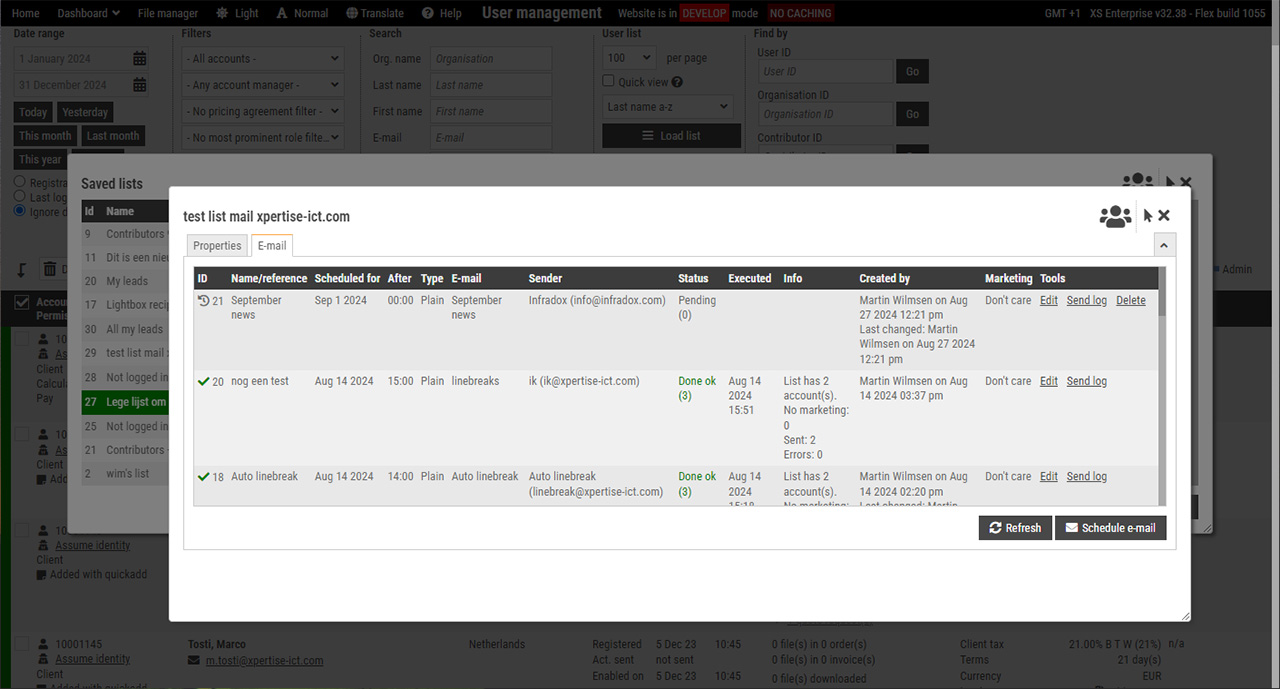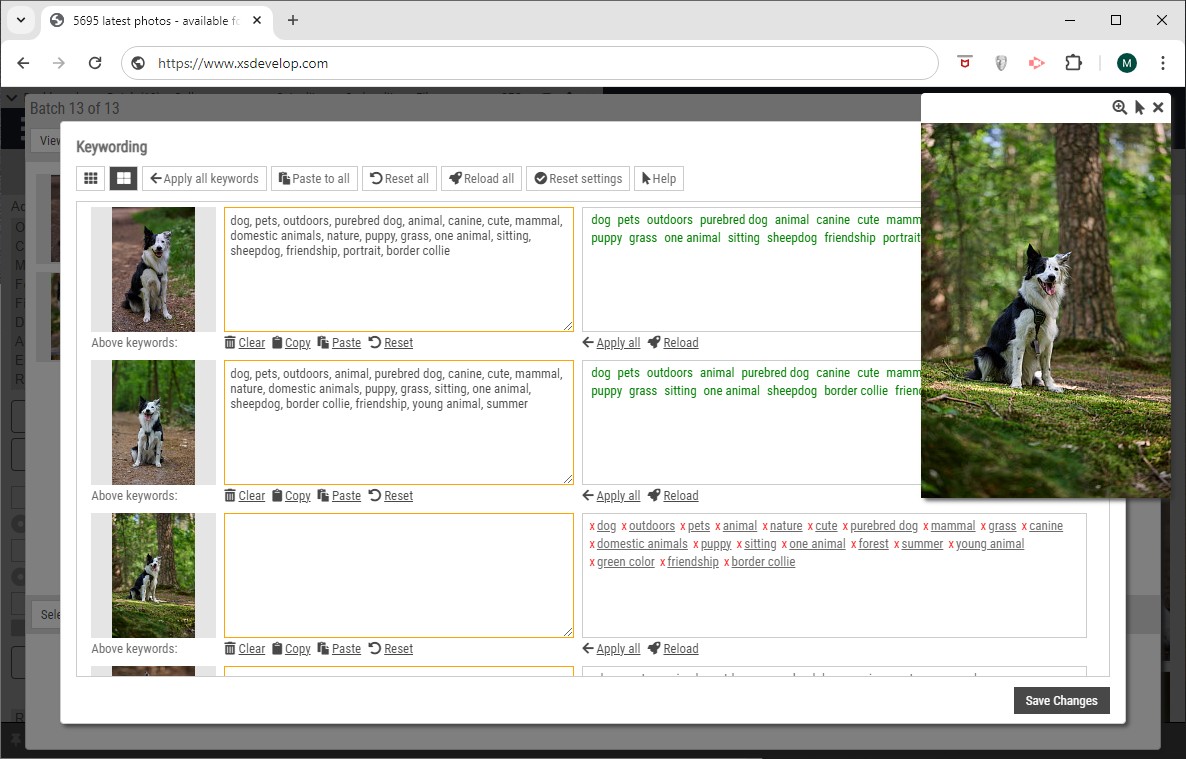While browsing thumbnail pages, the cart can be displayed as a panel – usually at the bottom of the screen. The cart page is the full screen version of the cart where the user enters the required information before confirming an order. The top of the cart page shows instructions that are relevant to the end user, i.e. the actual instructions depend on how the website is configured, on the user’s permissions and on the type of files in the cart. You can also create a custom cart page with the code editor.
Recommended reading
- Configuring the order/download page
- Asynchronous download jobs
- Configuring download permissions
- File collections and download sizes
- Anonymous delivery of files in an order
- Creating orders in a user’s account
- Price agreements and subscriptions
- Order/download FAQ
Constants
Some texts and labels that are used on the Cart page are stored in constants. The constants automatically display text in the active user interface language. You can change the constants, which is described in the article Website constants.
Disabling the cart and file ordering system
If you want to disable the cart and ordering system, then go to Site Configuration, Cart page and open the section Cart page settings. It is also possible to disable the cart page for all users except administrators.
Cart, Basket or Order
The default label to be used on the client facing pages is Cart. If you would like to change this, then go to Site Configuration, Constants and find the file constants-defaults.txt. You can change the label for the constant LBL_CART to whatever you prefer.
Cart page settings
Go to Site Configuration, Cart Page in the administrator menu (Back office) to change the settings of the cart page.
- Save button. The bottom of the cart page shows a button that must be clicked to confirm an order. To allow users to save the information they have entered without confirming (finalizing) the order, you can display a Save button. Note, if a user has “Direct download permissions”, the Save button will not appear for that user.
- Terms and conditions. The bottom of the cart page can show a link with a tick box that users must check to confirm that they agree to your terms and conditions. If a user has “Direct download permissions”, the accept terms checkbox will not appear. By default the standard terms and conditions are displayed when the user clicks the link, you can also change this to display separate terms that are specifically about the delivery of files. To edit the delivery terms, use the URL /delivery-terms when you are logged in as an admin. To enable separate delivery terms, go to Site configuration, Cart settings, open the section Cart page settings and select the radio button for delivery terms.
- Message box. You can display a message in a box that will cover most of the screen. You can choose to display a message to users who do not have immediate download permissions, you can display a different message to users who do have immediate download permissions, both or neither. The actual message can be edited on the cart page after you have enabled these settings. Note that you’ll need to login with accounts with the appropriate permissions to be able to edit the correct message. For instance if you want to display the message box to users that have no immediate download permissions, then you’ll have to login with an administrator account without immediate download permissions to be able to edit the message.
Two settings were added in version 31.4:
- Make the price calculator optional Enable this setting to allow users (that have the price calculator enabled on their account) to switch from the price calculator version of the cart to the “normal” version of the cart – and back. This option lets your clients decide on a per order basis if they need your help or not. If the user’s account is configured to require them to pay online, then switching to the version without the price calculator means that they won’t be able to pay online and that they’ll need to wait for a staff member to grant permissions on the order.
- Make paying online optional This setting lets users that are required to pay online, to place an order without paying online. A staff member will then have to review and grant permissions on the order.
Cart page instructions
Using HTML in your text fragments
The Support text fragment
Input of use details
- If you have granted a user “Direct download” permissions on a user’s account, then the input forms will not appear for that user.
- If you have enabled the price calculator for the user (you can do this for each user account separately) then the input forms will not appear for that user. A “pricing” button will appear instead. Note that in 31.4 or later, you can make using the price calculator optional (read above).
- Label, enter the label for the input field and use commas to separate locales if your site supports locales, e.g. Description, Beschrijving
- Minimum input length, select “not required” if the field is optional or select one of the predefined input lengths to make the field mandatory.
- Predefined values, leave blank if you want the user to enter any text or enter a list of values separated by semicolons (;). If your site supports multiple locales then use commas to separate the values for the different locales. Predefined values will appear as a drop down list box. If the minimum input length is “not required” then the user does not have to select a value, otherwise a value must be selected. Example value: Hardback;Paperback;Ebook;Website;Brochure;Advertising;Other
- Copy value to invoice description, if you have the invoicing module then tick this box if you want the field value to be copied to the description that is used for invoice details.
If a file is marked as RF or if the Price calculator is enabled on the user’s account
RF files will not show a use details input form because of the nature of Royalty Free. The user can select any of the configured file sizes and the price is set accordingly. If you want to allow your users to buy RF files with a RM licence instead, then enable the setting “Enable optional RM licences for RF files”.
If you have enabled the Price calculator on the user’s account then the input forms will not show for RM image files either. The user can select the different use details (e.g. circulation, size, type of use et cetera) in the Price calculator.
Input fields for the entire order, e.g. project reference
In Site configuration, Cart page, Cart page settings – you can configure three fields. You can use this if for example you want to let your clients enter project references. These values can be automatically copied to your invoices.
Direct download permissions
If you have granted Direct download permissions on a user’s account (note that this is not the same as Immediate download permissions) then you client will be able to download any file without having to go through the normal steps of ordering files. As a result, for such users the detail input forms will not display. Immediate download permissions on the other hand, allow a user to complete an order as configured (by filling out the details et cetera) and to then get download permissions automatically – without having to wait for a staff member.
Coupons
After you have added one or more coupon codes (Site configuration > Coupons in the side bar), you can enable “Coupon mode” in the cart page settings. When this setting is selected, an input box will appear at the bottom of the cart page where your users can enter a coupon code for a discount. Users can use each coupon code only once (for one order only), but you can of course create as many codes as you want. Each coupon code can have a limited validity (there’s a start and end date) and you can configure the type of content for which a specific coupon can be used.
Price agreements and/or subscriptions
Certain options (described above) may not apply if there are price agreements or subscriptions enabled on the user’s account. This is described in a separate article: Price agreements and subscriptions.




